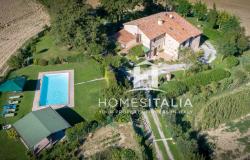Even as little as ten years ago, Italians knew little regarding the Halloween holiday. For most, it was just a strange American feast, something like an “Anglo-Saxon carnivalâ€. Nowadays, Halloween, through the influence of film and marketing is widely known and celebrated in Italy as well.
Quite a few Italian kids go trick-or-treating from door to door, even if they are still met with mixed reactions. Some are clearly not fully updated on the protocols of trick-or-treating and are slightly concerned about what to do with the group of masked little people standing on their doorstep. Others are more in step with the times and have heard about the new feast and are on standby with their treats.
Part of the problem is that there is no corresponding Italian Halloween holiday. Here, on the 1st of November, the "all saints day" people simply enjoy their day off work. On the contrary, the 2nd of November is a very important Italian holiday. It is the "day of the dead", during which the church remembers with special celebrations those who are no longer alive, people visit the cemetery taking flowers and candles to the graves of dead relatives and friends, and children find presents `brought’ to them by the dead .
As in other parts of the world, for example Mexico for `El dia de los muertos’ or Japan for `Obon festival’, it is a day dedicated to life and the family. The various traditions of the day express the strong attachment to life and to their families, both those who are alive and those who are no longer with them. This is especially visible in the traditions that involve children since they create and reinforce links between them and those members of the family that are not alive anymore.
Until a few decades ago and especially in the South of Italy, this was in fact the only celebration of the year when children received presents, usually sweets and toys. Today there are many other occasions during the year (Christmas, Epifania, Birthdays, etc.) and the tradition risks loosing its impact on younger generations. However, many families still keep it alive. Parents tell their children that if they behave correctly, the good souls of the dead might bring them presents. On the 1st of November, children go to bed in the hope to be remembered by dead members of the family while parents prepare the presents and hide them around the house. In Sicily (and Sicilian dialect) one of the traditional sayings for the children to ask for many presents is this:
“Armi santi, armi santi,
Io sugnu unu e vuatri siti tanti
Mentri sugnu ‘ntra stu munnu di guai
Cosi di morti mittitiminni assai.â€
“Holy souls, holy souls,
I am one, and you are many,
While I am in this world of troubles,
Bring me lots of presents from dead peopleâ€
The morning after the search begins as soon as they wake up and after having found them they get ready to go to visit the cemetery. This is not a sad day in any way; it is a day where `two worlds’ meet to celebrate life.
 As with an holiday special sweets are never far away. Of course this vary from region to region and town to town. One of the most characteristic ones is that of Romagna, the "piada dei morti", literally piada of the dead! Even if the name could frighten you, this is a very tasty sweet! It’s a flatbread with nuts, almonds, raisins and red sangiovese wine in the mixture, with the shape of a disc. You can find it only between October and November and only in Romagna (from Rimini to Cesena). Another “dead-sweet†is the broad-bean of the dead, a little biscuit made of almonds. In the last days of October, baker’s and confectioneries are full of these sweets, and the people queue up to have their piece!
As with an holiday special sweets are never far away. Of course this vary from region to region and town to town. One of the most characteristic ones is that of Romagna, the "piada dei morti", literally piada of the dead! Even if the name could frighten you, this is a very tasty sweet! It’s a flatbread with nuts, almonds, raisins and red sangiovese wine in the mixture, with the shape of a disc. You can find it only between October and November and only in Romagna (from Rimini to Cesena). Another “dead-sweet†is the broad-bean of the dead, a little biscuit made of almonds. In the last days of October, baker’s and confectioneries are full of these sweets, and the people queue up to have their piece!
 These sweets always have distinguished this strange holiday, making it very beloved by Romagnoli. Even if the new and the old generation has absorbed the Celtic holiday of Halloween (although some “Padano†boasts that Halloween is also an Italian feast, because of the presence of the Celts in north Italy), piada and fave dei morti bring to life the taste of the feast and the memories.
These sweets always have distinguished this strange holiday, making it very beloved by Romagnoli. Even if the new and the old generation has absorbed the Celtic holiday of Halloween (although some “Padano†boasts that Halloween is also an Italian feast, because of the presence of the Celts in north Italy), piada and fave dei morti bring to life the taste of the feast and the memories.












